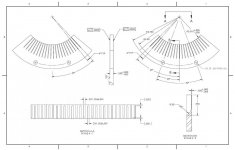Hello,
I'm new to the forum so forgive me if this post is in the wrong section. I need a part to be made, but the local machine shops all seem to not want to quote this job. I asked a couple of them and they all seem to say it is too difficult to machine. I tried to attach a drawing of the part and a hand sketch of how i would machine it. I've done basic machining in the past, but this one does seem a bit challenging. Please let me know how you think it should be machined.
Please note that the part will be clamped between two plates so if the part springs to a non-flat shape, it will still be okay.


Thanks,
Nick
I'm new to the forum so forgive me if this post is in the wrong section. I need a part to be made, but the local machine shops all seem to not want to quote this job. I asked a couple of them and they all seem to say it is too difficult to machine. I tried to attach a drawing of the part and a hand sketch of how i would machine it. I've done basic machining in the past, but this one does seem a bit challenging. Please let me know how you think it should be machined.
Please note that the part will be clamped between two plates so if the part springs to a non-flat shape, it will still be okay.


Thanks,
Nick

